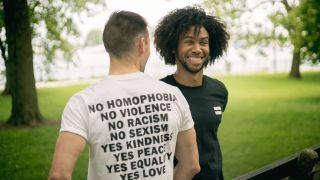Career
Avoiding Ineffective Allyship
Switching from well-intentioned to impactful actions.
Posted April 17, 2023 Reviewed by Davia Sills
Key points
- Some allyship actions are well-intended but have negative impacts.
- Allies need to take steps to educate themselves, address their own biases, notice differences, and not add additional labor onto others.
- Instead of shifting the focus to themselves, allies should amplify the voices of equity-deserving individuals.
- Be courageous and stand up when there are instances of disrespect, bias, or exclusion.

Allyship involves actions that are helpful to those in marginalized or equity-deserving groups. Some allies engage in well-intended but ineffective behaviors. These behaviors can lead to poorer psychological safety, negative feelings, and anxiety. Recent research by Lauren A. Collier-Spruel and Ann Marie Ryan examined allyship behaviors to determine the most effective versus ineffective actions.
Ineffective Allyship
- Performative allyship: This refers to actions that make you look good or gain approval from others, rather than being genuinely committed to supporting marginalized groups. This type of allyship often involves making public statements or engaging in surface-level activism without taking any substantive action to address the root causes of inequality.
- Centering on oneself: Ineffective allies may focus too much on their own experiences and feelings, rather than truly listening to and supporting the needs of marginalized groups. This can involve interrupting or talking over members of marginalized groups or making the conversation about oneself rather than the issues at hand.
- Tone policing: In some cases, allies may criticize the way that marginalized individuals express their feelings or opinions, rather than focusing on the substance of what they are saying. This can be harmful, as it can silence marginalized voices and prevent them from being heard.
- Failure to take action: Finally, ineffective allies may talk a lot about the need for change, but fail to take concrete steps to make a difference. This can include failing to challenge oppressive behavior when it occurs or failing to support marginalized individuals in meaningful ways.
These unhelpful behaviors were actually associated with feelings of poorer psychological safety, less positive feelings, more negative feelings, and anxiety. Do not read this and think, "Oh well then, I just won't do anything." The world is becoming more divisive, and 42 percent of individuals are actively rejecting DEI initiatives in the workplace; more than ever, we need allies to do the right thing. By avoiding these ineffective allyship behaviors, we can become more effective allies and work to promote greater equity and inclusion in our communities.
Effective Allyship
Here are some effective allyship behaviors that can help promote greater equity and inclusion:
- Listening and learning: Effective allies take the time to listen to and learn from members of marginalized groups. They seek out opportunities to hear diverse perspectives and challenge their own biases and assumptions.
- Using privilege to support marginalized individuals: Allies can use their privilege (whether that be based on race, gender, sexuality, or other factors) to support marginalized individuals and amplify their voices. This can involve advocating for policy changes, promoting diversity and inclusion within their workplace, or using their platform to raise awareness about important issues.
- Taking action: Effective allies take concrete steps to address inequality and promote inclusion. This may involve donating to organizations that support marginalized groups, participating in protests or other forms of activism, or speaking out against oppressive behavior when it occurs.
- Centering on marginalized voices: Finally, effective allies center on the voices and experiences of marginalized individuals, rather than making the conversation about themselves. They use their platform to amplify marginalized voices and create space for them to be heard.
It's essential for allies to not just be "well-intentioned" but to be "well-actioned." By engaging in these effective allyship behaviors, we can work towards creating a more equitable and inclusive society for all. Effective allyship should increase a feeling of inclusion and acceptance, empowering and advocating for the recipient.
Please refer to the great work in the references for more information.
References
Collier-Spruel, L. A., & Ryan, A. M. (2022). Are All Allyship Attempts Helpful? An Investigation of Effective and Ineffective Allyship. Journal of Business and Psychology, 1-26. https://idp.springer.com/authorize/casa?redirect_uri=https://link.springer.com/article/10.1007/s10869-022-09861-9&casa_token=VghUjZZkD98AAAAA:zgzBuwEcz5Qqlc0JyaTVcSlP4TRZpRoT0Vn7NDEMI0D6mS6xW5O3QlFzvqE9Fd0YGN2qbGi1Nu4eMy9LBg
Carlson, J., Leek, C., Casey, E., Tolman, R., & Allen, C. (2019). What’s in a name? A synthesis of “allyship” elements from academic and activist literature. Journal of Family Violence. https://doi.org/10.1007/s10896-019-00073-z
Charles, C. (2016, October 15). 10 Common things well-intentioned allies do that are actually counterproductive. Medium. https://medium.com/reclaiming-anger/10-common-things-well-intentioned-allies-do-that-are-actually-counterproductive-af3dda187822
Craig, M. A., Badaan, V., & Brown, R. M. (2020). Acting for whom, against what? group membership and multiple paths to engage- ment in social change. Current Opinion in Psychology, 35, 41–48. https://doi.org/10.1016/j.copsyc.2020.03.002
Gartner, 2021


